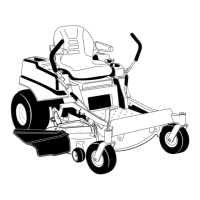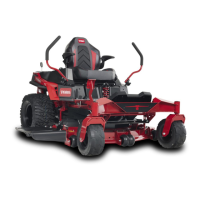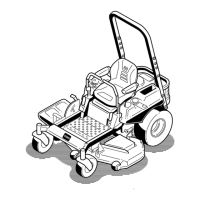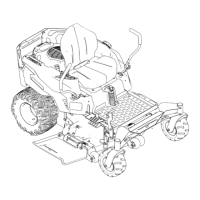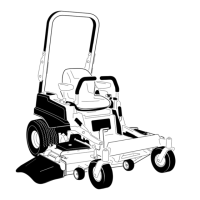21
Understanding the Safety Interlock
System
The safety interlock system is designed to
prevent the engine from starting unless:
• The blades are disengaged.
• The motion control levers are in the
neutral position.
• The parking brake is engaged.
The safety interlock system is designed to
initiate engine shutdown when:
• The parking brake is disengaged and the
operator gets off machine.
• The PTO is engaged and the operator
gets off machine.
• The parking brake is disengaged and
levers are in and the operator gets off
machine.
• The parking brake is engaged and motion
control levers are in.
Testing the Safety Interlock System
Test the safety interlock system before you
use the machine each time.
1. Check starting circuit. Starter should crank
with parking brake engaged, PTO
disengaged and motion control levers
moved out in the neutral lock position. The
operator does not need to be in the seat to
start the engine.
2. Try to start with operator in seat, parking
brake disengaged, PTO disengaged and
motion control levers in the neutral lock
position - starter must not crank.
3. Try to start with operator in seat, parking
brake engaged, PTO engaged and motion
control levers in the neutral lock position -
starter must not crank.
4. Try to start with operator in seat, parking
brake engaged, PTO disengaged, and the
left motion control lever in, starter must
not crank, repeat again with the right lever
in, then with both levers in - starter must
not crank.
5. Check kill circuits. Run engine at one-third
throttle, disengage parking brake and raise
off of seat (but do not get off of machine)
engine must initiate shutdown.
6. Run engine at one-third throttle, engage
PTO and raise off of seat (but do not get off
of machine) engine must initiate
shutdown.
7. Run engine at one-third throttle, with brake
disengaged, move levers in and raise off
seat (but do not get off of machine) engine
must initiate shutdown.
8. Again, run engine at one-third throttle, brake
engaged, and move left motion control
lever in - engine must initiate shutdown.
9. Repeat again moving the right lever in
,
then moving both levers in - engine must
initiate shutdown whether operator is on
seat or not.
NOTE: If machine does not pass any
of these tests, do not operate. Contact
your authorized TORO SERVICE
DEALER.
IMPORTANT: It is essential that
operator safety mechanisms be
connected and in proper operating
condition prior to use for mowing.
Driving Forward or Backward
The throttle control regulates the engine
speed as measured in rpm (revolutions per
minute). Place the throttle control in the Fast
position for best performance. Always
operate in the Fast (full throttle) position.
The machine can spin very rapidly.
The operator may lose control of the
machine and cause personal injury or
damage to the machine.
• Use caution when making turns.
• Slow the machine down before
making sharp turns.

